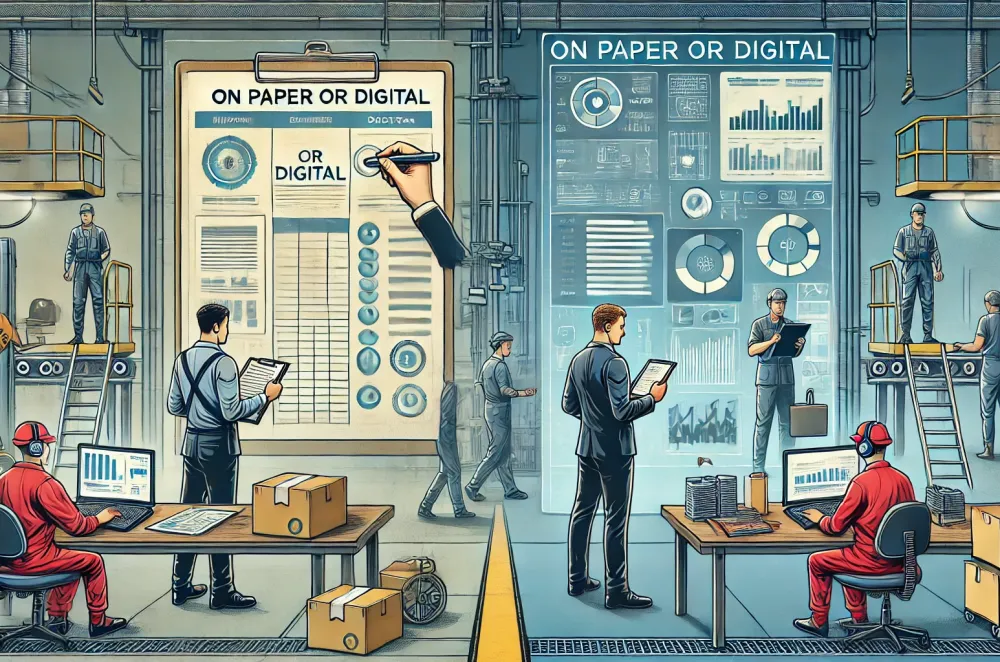On Paper or Digital: Why Many Manufacturers Still Use Old-Fashioned Ways to Monitor Production
Despite the proliferation of digital solutions, many manufacturers continue to rely on traditional methods, such as paper-based systems, to monitor production. This persistence can be attributed to several factors, including cost, complexity, cultural inertia, and the specific needs of certain manufacturing environments. Here’s a detailed look at why old-fashioned monitoring methods are still prevalent in the manufacturing sector.
1. Cost Concerns
Initial Investment:
Implementing digital monitoring systems involves significant upfront costs, including purchasing hardware, software, and the necessary infrastructure upgrades. For many small to medium-sized enterprises (SMEs), these costs can be prohibitive.
Example:
A small manufacturer may find it difficult to justify the expenditure on an advanced digital monitoring system when paper-based methods, though less efficient, incur minimal costs.
2. Complexity and Integration Challenges
Integration with Legacy Systems:
Many manufacturers operate with legacy systems that are not easily compatible with modern digital solutions. Integrating new technology with existing processes can be technically challenging and costly.
Technical Expertise:
Digital transformation requires a certain level of technical expertise and ongoing IT support. Manufacturers without in-house IT capabilities may find it daunting to maintain and troubleshoot new digital systems.
Example:
A factory using outdated machinery might struggle to integrate these machines with modern IoT sensors and software, making paper-based tracking a simpler, though less efficient, alternative.
3. Cultural Resistance and Change Management
Resistance to Change:
Employees and management accustomed to traditional methods may resist adopting new technologies. This resistance can stem from a fear of the unknown, perceived job threats, or a simple preference for familiar processes.
Training Needs:
Transitioning to digital systems requires training for the workforce, which can be time-consuming and costly. Some manufacturers may delay or avoid digital adoption due to the perceived disruption this training entails.
Example:
Long-standing employees in a manufacturing plant may be reluctant to switch from paper logs to digital tablets, preferring the familiarity and simplicity of the methods they have used for years.
4. Specific Industry Requirements
Regulatory Compliance:
In some industries, regulatory requirements dictate specific methods for recording and reporting data. Paper-based systems may be well-established in these regulatory frameworks, making digital transition more complex.
Reliability and Redundancy:
Certain manufacturing environments, particularly those with harsh conditions, might find paper-based systems more reliable. Digital systems can be susceptible to power outages, network failures, or technical glitches.
Example:
In highly regulated industries like pharmaceuticals or aerospace, manufacturers may rely on paper records to ensure compliance with stringent documentation standards.
5. Perception of Adequacy
Sufficient for Needs:
For some manufacturers, traditional methods may be perceived as adequate for their current operational scale and complexity. If paper-based monitoring meets their needs without significant drawbacks, there may be little incentive to change.
Example:
A small-scale artisan manufacturer may find that manual record-keeping is sufficient for tracking production and quality control, negating the perceived need for digital systems.
Conclusion
While digital monitoring systems offer substantial benefits in terms of efficiency, accuracy, and data analytics, many manufacturers continue to rely on traditional paper-based methods due to cost concerns, integration challenges, cultural resistance, regulatory requirements, and perceived adequacy of existing methods. Understanding these factors is crucial for any initiatives aimed at encouraging digital transformation in the manufacturing sector.
Manufacturers considering the shift to digital should weigh these challenges against the potential long-term benefits and develop strategies to mitigate resistance and ease the transition process. This might include phased implementation, targeted training programs, and ensuring robust support systems to address technical issues.
Interested in digital transformation? Let's discuss!
